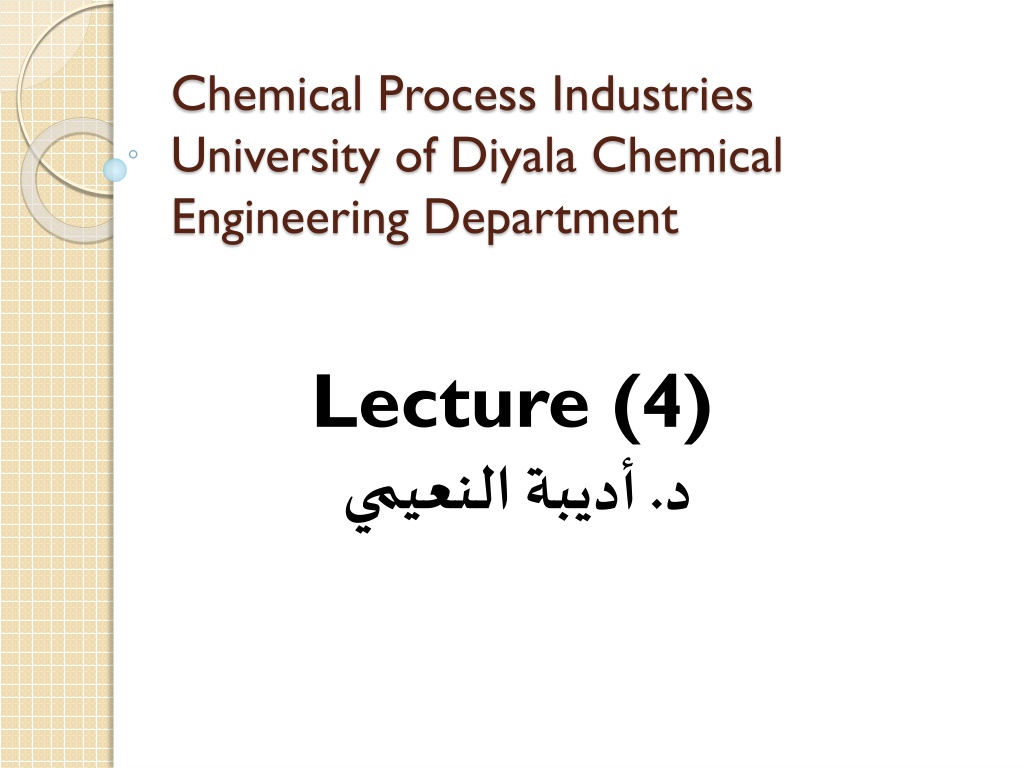Evolution of Regulation in the Pharmaceutical Industry
The pharmaceutical industry plays a crucial role in discovering, developing, and marketing drugs for patient use. Historical incidents of unsafe drugs led to the implementation of regulations such as the Biologics Control Act of 1902 and the Pure Food and Drugs Act of 1906. These laws aimed to ensure the safety and efficacy of medications, emphasizing pre-market safety demonstrations and prohibiting false therapeutic claims.
Download Presentation

Please find below an Image/Link to download the presentation.
The content on the website is provided AS IS for your information and personal use only. It may not be sold, licensed, or shared on other websites without obtaining consent from the author. Download presentation by click this link. If you encounter any issues during the download, it is possible that the publisher has removed the file from their server.
E N D
Presentation Transcript
Chemical Process Industries University of Diyala Chemical Engineering Department Lecture (4) .
pharmaceutical industry The pharmaceutical industry discovers, develops, produces, and markets drugs or pharmaceutical drugs for use as medications to be administered (or self-administered) to patients, with the aim to cure them,vaccinate them, or alleviate the symptoms.[1][2]Pharmaceutical companies may deal in generic or brand medications and medical devices. They are subject to a variety of laws and regulations that govern the patenting, testing, safety, efficacy and marketing of drugs.
Unsafe drugs and early industry regulation Prior to the 20th century drugs were generally produced by small scale manufacturers with little regulatory control over manufacturing or claims of safety and efficacy. To the extent that such laws did exist, enforcement was lax. In the United States, increased regulation of vaccines and other biological drugs was spurred by tetanus outbreaks and deaths caused by the distribution of contaminated smallpox vaccine and diphtheria antitoxin.[23]The Biologics Control Act of 1902 required that federal government grant premarket approval for every biological drug and for the process and facility producing such drugs. This was followed in 1906 by the Pure Food and Drugs Act, which forbade the interstate distribution of adulterated or misbranded foods and drugs
A drug was considered misbranded if it contained alcohol, morphine, opium, cocaine, or any of several other potentially dangerous or addictive drugs, and if its label failed to indicate the quantity or proportion of such drugs. The government's attempts to use the law to prosecute manufacturers for making unsupported claims of efficacy were undercut by a Supreme Court ruling restricting the federal government's enforcement powers to cases of incorrect specification of the drug's ingredients
In 1937 over 100 people died after ingesting "Elixir Sulfanilamide" manufactured by S.E. Massengill Company of Tennessee. The product was formulated in diethylene glycol, a highly toxic solvent that is now widely used as antifreeze.[25]Under the laws extant at that time, prosecution of the manufacturer was possible only under the technicality that the product had been called an "elixir", which literally implied a solution in ethanol. In response to this episode, the U.S. Congress passed the Federal Food, Drug, and Cosmetic Act of 1938, which for the first time required pre-market demonstration of safety before a drug could be sold, and explicitly prohibited false therapeutic claims
he pharmaceutical industry is a unique and significant component of the international economy. It faces ethical issues distinct from other industries. There are a few powerful players controlling the supply of arguably the most critical products in an economy. A pressing ethical issue for pharmaceutical companies is whether they ought to be held to a higher standard than those in other industries due to their role in serving the public good. How can earning a profit be a company s single most important concern if this goal prevents a consumer from purchasing a lifesaving drug? Do pharmaceutical companies have a moral duty to invest in treatment research, a societal good, even if they lose money in the process?
Pharmaceutical companies can profit from patent laws intended to promote social good but which instead create perverse incentives, or fail to adequately incentivize. Even if patent protection secures exclusive rights to sell a product, it still may not be profitable for a company to invest in certain drug development.
Inevitable patent laws, the consequent lack of competition, and crucial public interest in accessing these drugs are distinctive characteristics of the pharmaceutical industry. As such, policies ought to encourage companies in this industry to keep drug prices low and to develop new treatments for humanitarian rather than pure profit motives.
Characteristics of the Pharmaceutical Industry In many industries, a consumer will simply not participate in the market if his demand is lower than the market price. However in the case of vital medication, demand is so inelastic the supplier could charge an exorbitant price and demand would remain steady. Essentially, pharmaceutical suppliers can put a price on human life and that price can be high.
A controversial example of extreme price setting by Turing Pharmaceuticals occurred in 2015. Turing acquired Daraprim, a drug used to treat life- threatening parasitic infections called toxoplasmosis (NY Times). The infection is most deadly for AIDS patients and some cancer patients. Almost immediately after acquiring the drug, CEO Martin Shkreli raised the price per tablet from $13.50 to $750. While the drastic increase caused public outcry, the operation was legal and could potentially earn Turing millions in profits (NY Times). Although insurers have the option to continue to pay for the drug, they will likely turn to a cheaper, less effective treatment after this price hike.

